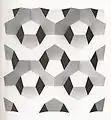Squaring the square
Squaring the square is the problem of tiling an integral square using only other integral squares. (An integral square is a square whose sides have integer length.) The name was coined in a humorous analogy with squaring the circle. Squaring the square is an easy task unless additional conditions are set. The most studied restriction is that the squaring be perfect, meaning the sizes of the smaller squares are all different. A related problem is squaring the plane, which can be done even with the restriction that each natural number occurs exactly once as a size of a square in the tiling. The order of a squared square is its number of constituent squares.
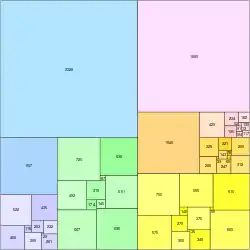
Perfect squared squares
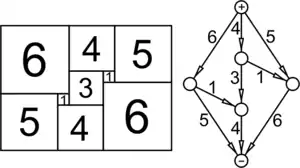
A "perfect" squared square is a square such that each of the smaller squares has a different size.
It is first recorded as being studied by R. L. Brooks, C. A. B. Smith, A. H. Stone and W. T. Tutte at Cambridge University between 1936 and 1938. They transformed the square tiling into an equivalent electrical circuit — they called it a "Smith diagram" — by considering the squares as resistors that connected to their neighbors at their top and bottom edges, and then applied Kirchhoff's circuit laws and circuit decomposition techniques to that circuit. The first perfect squared squares they found were of order 69.
The first perfect squared square to be published, a compound one of side 4205 and order 55, was found by Roland Sprague in 1939.[2]
Martin Gardner published an extensive article written by W. T. Tutte about the early history of squaring the square in his mathematical games column in November 1958.[3]
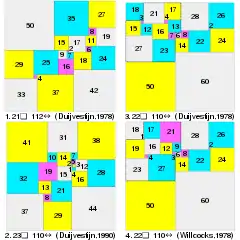
Simple squared squares
A "simple" squared square is one where no subset of the squares forms a rectangle or square, otherwise it is "compound".
In 1978, A. J. W. Duijvestijn discovered a simple perfect squared square of side 112 with the smallest number of squares using a computer search. His tiling uses 21 squares, and has been proved to be minimal.[4] This squared square forms the logo of the Trinity Mathematical Society. It is also appears on the cover of the Journal of Combinatorial Theory.
Duijvestijn also found two simple perfect squared squares of sides 110 but each comprising 22 squares. Theophilus Harding Willcocks, an amateur mathematician and fairy chess composer, found another. In 1999, I. Gambini proved that these three are the smallest perfect squared squares in terms of side length.[5]
The perfect compound squared square with the fewest squares was discovered by T.H. Willcocks in 1946 and has 24 squares; however, it was not until 1982 that Duijvestijn, Pasquale Joseph Federico and P. Leeuw mathematically proved it to be the lowest-order example.[6]
Mrs. Perkins's quilt
When the constraint of all the squares being different sizes is relaxed, a squared square such that the side lengths of the smaller squares do not have a common divisor larger than 1 is called a "Mrs. Perkins's quilt". In other words, the greatest common divisor of all the smaller side lengths should be 1.
The Mrs. Perkins's quilt problem is to find a Mrs. Perkins's quilt with the fewest pieces for a given n × n square.
No more than two different sizes
A cute number means a positive integer n such that some square admits a dissection into n squares of no more than two different sizes, without other restrictions. It can be shown that aside from 2, 3, and 5, every positive integer is cute.[7]
Squaring the plane
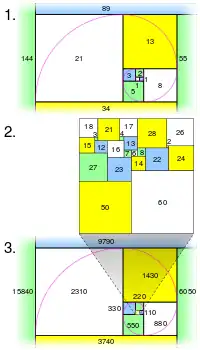
In 1975, Solomon Golomb raised the question whether the whole plane can be tiled by squares, one of each integer edge-length, which he called the heterogeneous tiling conjecture. This problem was later publicized by Martin Gardner in his Scientific American column and appeared in several books, but it defied solution for over 30 years.
In Tilings and Patterns, published in 1987, Branko Grünbaum and G. C. Shephard stated that in all perfect integral tilings of the plane known at that time, the sizes of the squares grew exponentially. For example, the plane can be tiled with different integral squares, but not for every integer, by recursively taking any perfect squared square and enlarging it so that the formerly smallest tile now has the size of the original squared square, then replacing this tile with a copy of the original squared square.
In 2008 James Henle and Frederick Henle proved that this, in fact, can be done.[8] Their proof is constructive and proceeds by "puffing up" an L-shaped region formed by two side-by-side and horizontally flush squares of different sizes to a perfect tiling of a larger rectangular region, then adjoining the square of the smallest size not yet used to get another, larger L-shaped region. The squares added during the puffing up procedure have sizes that have not yet appeared in the construction and the procedure is set up so that the resulting rectangular regions are expanding in all four directions, which leads to a tiling of the whole plane.
Cubing the cube
Cubing the cube is the analogue in three dimensions of squaring the square: that is, given a cube C, the problem of dividing it into finitely many smaller cubes, no two congruent.
Unlike the case of squaring the square, a hard yet solvable problem, there is no perfect cubed cube and, more generally, no dissection of a rectangular cuboid C into a finite number of unequal cubes.
To prove this, we start with the following claim: for any perfect dissection of a rectangle in squares, the smallest square in this dissection does not lie on an edge of the rectangle. Indeed, each corner square has a smaller adjacent edge square, and the smallest edge square is adjacent to smaller squares not on the edge.
Now suppose that there is a perfect dissection of a rectangular cuboid in cubes. Make a face of C its horizontal base. The base is divided into a perfect squared rectangle R by the cubes which rest on it. The smallest square s1 in R is surrounded by larger, and therefore higher, cubes. Hence the upper face of the cube on s1 is divided into a perfect squared square by the cubes which rest on it. Let s2 be the smallest square in this dissection. By the claim above, this is surrounded on all 4 sides by squares which are larger than s2 and therefore higher.
The sequence of squares s1, s2, ... is infinite and the corresponding cubes are infinite in number. This contradicts our original supposition.[9]
If a 4-dimensional hypercube could be perfectly hypercubed then its 'faces' would be perfect cubed cubes; this is impossible. Similarly, there is no solution for all cubes of higher dimensions.
See also
References
- "o55-4205-sprague.pdf" (PDF). Retrieved 25 August 2015.
- "5. Towards a theory for combinatorial games". American Mathematical Society. Retrieved 2017-06-30.
- "Brooks, Smith, Stone and Tutte, II". www.squaring.net. Retrieved 19 April 2018.
- W., Weisstein, Eric. "Perfect Square Dissection". mathworld.wolfram.com. Retrieved 19 April 2018.
- Gambini, Ian (1999). "A method for cutting squares into distinct squares". Discrete Applied Mathematics. 98 (1–2): 65–80. doi:10.1016/S0166-218X(99)00158-4. MR 1723687.
- Duijvestijn, A. J. W.; Federico, P. J.; Leeuw, P. (1982). "Compound perfect squares". American Mathematical Monthly. 89 (1): 15–32. doi:10.2307/2320990. MR 0639770.
- Henry, JB; Taylor, PJ. Challenge! 1999 - 2006 Book 2. Australian Mathematics Trust. p. 84. ISBN 978-1-876420-23-9.
- Henle, Frederick V.; Henle, James M. (2008). "Squaring the plane". American Mathematical Monthly. 115: 3–12. JSTOR 27642387.
- Brooks, R. L.; Smith, C. A. B.; Stone, A. H.; Tutte, W. T. (1940). "The dissection of rectangles into squares". Duke Math. J. 7 (1): 312–340. doi:10.1215/S0012-7094-40-00718-9. MR 0003040.
Further reading
- C. J. Bouwkamp and A. J. W. Duijvestijn, Catalogue of Simple Perfect Squared Squares of Orders 21 Through 25, Eindhoven Univ. Technology, Dept. of Math., Report 92-WSK-03, Nov. 1992.
- Bouwkamp, C. J.; Duijvestijn, A. J. W. (Dec 1994). "Album of Simple Perfect Squared Squares of order 26" (PDF). EUT Report 94-WSK-02., Eindhoven University of Technology, Faculty of Mathematics and Computing Science
- Martin Gardner, "Squaring the square," in The 2nd Scientific American Book of Mathematical Puzzles and Diversions.
- Henle, Frederick V.; Henle, James M. (2008). "Squaring the plane" (PDF). American Mathematical Monthly. 115: 3–12. JSTOR 27642387. Archived from the original (PDF) on 2006-06-20.
- Wynn, Ed (2013). "Exhaustive generation of Mrs Perkins's quilt square dissections for low orders". arXiv:1308.5420.
External links
| Wikimedia Commons has media related to Squaring the square. |
- Perfect squared squares:
- http://www.squaring.net/
- http://www.maa.org/editorial/mathgames/mathgames_12_01_03.html
- http://www.math.uwaterloo.ca/navigation/ideas/articles/honsberger2/index.shtml
- https://web.archive.org/web/20030419012114/http://www.math.niu.edu/~rusin/known-math/98/square_dissect
- http://www.stat.ualberta.ca/people/schmu/preprints/sq.pdf
- Nowhere-neat squared squares:
- Mrs. Perkins's quilt:

